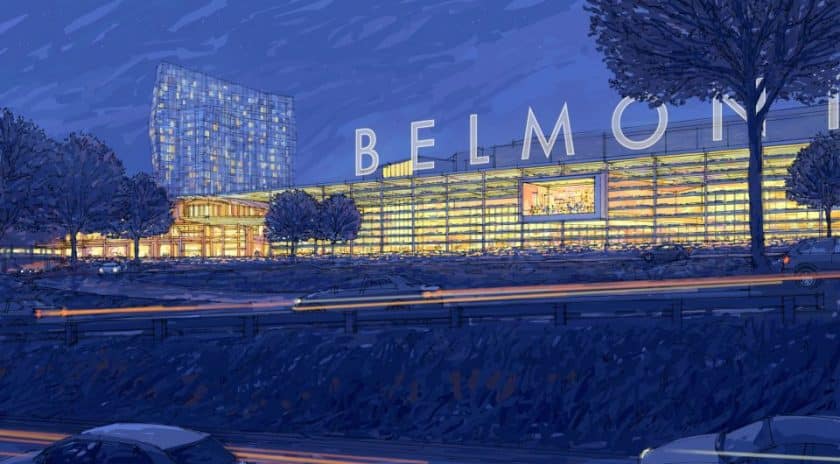What’s next for the New York Islanders’ arena at Belmont Park

The New York Islanders’ new arena at Belmont Park is moving into the final stages of the approval process — here’s what comes next.
[sc name=”Justin Weiss Banner”]Over the past nineteen months, the New York Islanders have worked vigorously to develop a brand-new, state-of-the-art arena at Belmont Park. Finally, that battle may be nearing its conclusion.
On July 9, Empire State Development adopted a report that expressed the impact of the arena on the surrounding community — a crucial step in the approval process. With that out of the way, the Islanders are now closer to putting a shovel in the ground than they have ever been before.
Just hours before the agency adopted the environmental impact report, the state announced its plans to build a full-time, $105 million Long Island Rail Road station about a mile from the proposed arena, which is seen as a pivotal step in decreasing congestion and winning the support of project critics.
The state must first conduct a feasibility study before beginning construction on a full-time station. After the completion of the report, the MTA Board must approve the LIRR stop. For the Islanders, the challenge is making the train a viable and attractive option while also ensuring that the electric shuttle buses taking patrons from the station to the arena are efficiently run.
For the project to reach its final stage, the Islanders need to hold another public comment period and gain approval from three state boards. Once they navigate these steps, they can finally break ground on a new stadium. Jon Ledecky, the club’s co-owner, has said that he still expects the project to be completed by the start of the 2021-22 hockey season.
In the interim, the Islanders will be working with the state to ensure that everything goes smoothly with the Elmont train station, which will connect to point’s east and west — a major sticking point in the long-ranging debate over the station’s construction.
Throughout the approval process, all parties have acknowledged the logistical and infrastructural hurdles the full-time station faces, according to Alfonso A. Castillo of Newsday. Currently, trains only run through the Elmont station during racing season, and only travel to points west. Rerouting trains to points east is a “complicated and disruptive maneuver” that could boost congestion, MTA Chairman Joe Lhota has said in the past.
The station would reduce traffic from 83% to 48% during sold-out events, said Rachel Shatz, Vice President for Planning and Environmental Review at Empire State Development. The state projects that anywhere between 24 and 30% of patrons will take the LIRR to arena events.
[sc name=”Islanders Center”]“For the Belmont arena to be successful, mass transit must be a viable option for people to get to and from major events,” New York State Sen. Todd Kaminsky (D-LB) told reporters in July 2018. “The LIRR should be creative and daring in generating options for the type of service possible at Belmont.”
Floral Park and Elmont residents have voiced concerns over the scope and impact of the Belmont arena. In May 2018, a group of protestors carried signs like “Selling hot dogs doesn’t pay the rent,” and expressed unanimous opposition to the proposal: “What’s the new development going to do for us?” asked Aubrey Phillips of Elmont to Ted Phillips of Newsday. “The jobs are not going to be high paying.”
The full-time LIRR station comes largely in response to concerns over congestion, which is expected to increase on Hempstead Turnpike and the Cross Island Parkway. Questions have also been raised over the additional cost of road maintenance, the logistics of parking and the safety problems posed by an influx in drivers and construction.
The development will include a 19,000-seat, year-round arena, 350,000 square feet of retail space, 10,000 square feet of community space, a 250-room hotel, restaurants and a movie theater.
The Islanders have been searching for a new home on Long Island for over a decade. In August 2007, then-Islanders owner Charles Wang proposed the Lighthouse Project, an ambitious plan to renovate Nassau Coliseum, build a minor-league baseball stadium and 60-story Lighthouse, and construct housing units and retail space.
Critics of the plan argued that it was too dense for the community; in 2011, voters rejected a referendum to fund the publicly-financed project.
The Islanders signed a 25-year lease with Brooklyn’s Barclays Center in 2012, but that relationship was doomed from the start. The Islanders returned home to the Coliseum this season, where they played 21 games. The league disputes the notion that the club could move back to the Coliseum full-time, citing its lack of size (seating a league-trailing 13,917 people for hockey) and outdated nature (built in 1971, it is the second-oldest arena in the league).
Throughout the process, Islanders owners, coaches, and players have been publicly optimistic about the prospects of the new arena. “I would not have come here [to the Islanders] if there was not going to be a new arena,” Islanders general manager Lou Lamoriello told Mark Hermann of Newsday in May. “We, as players, have all the faith in them that it’s going to happen,” said defenseman Ryan Pulock.
Even Gary Bettman, the league’s commissioner, believes the arena is on its way. “I’m expecting to be at a groundbreaking sometime in the next few months,” he said at the Associated Press Sports Editors meeting in early May. “It’s still coming. I have no reason to believe it’s not.”
[sc name=”Islanders Link Next” link=”https://elitesportsny.com/2019/07/22/new-york-islanders-prospect-rankings-noah-dobson-headlines/” text=” New York Islanders Prospect Rankings: Noah Dobson Headlines” ]Justin Weiss is a staff editor at Elite Sports New York, where he covers the New York Islanders and Brooklyn Cyclones. In 2016, he received a Quill Award for Freelance Journalism. He has written for the Long Island Herald, FanSided and YardBarker.






